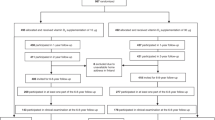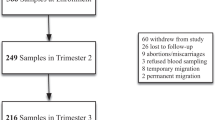Abstract
Background/objectives:
C-reactive protein (CRP) is the most extensively studied inflammatory risk marker, and elevated serum CRP concentrations in pregnant women are known to be associated with subsequent development of preeclampsia and preterm delivery. Researchers have suggested that folate intake may help to control the inflammation process. We examined whether folate nutrition modifies the relationship between serum CRP concentration and gestational age at delivery.
Subjects/methods:
Serum CRP concentrations were analyzed in 815 pregnant women between 12 and 28 weeks of gestation. Dietary intakes were assessed using a 24-h dietary recall. The serum folate and high-sensitivity CRP concentrations were analyzed by radioassay and latex agglutination tests, respectively.
Results:
Serum CRP concentration was negatively correlated (P<0.001) with gestational age at delivery. Serum folate concentration was negatively correlated (P<0.01) with serum CRP concentration, and total dietary folate intake was positively correlated (P<0.001) with serum folate concentration. Multiple regression analysis after adjustment for covariates revealed that maternal CRP concentrations were negatively associated with gestational age at delivery; these negative associations existed only when folate intake during pregnancy was below the Korean estimated average requirements (520 μg dietary folate equivalent per day), and serum folate concentrations were above the normal (6 ng/ml).
Conclusions:
We found that adequate maternal folate intake during pregnancy may have a beneficial role against shorter gestational age at delivery, which is associated with higher serum CRP concentrations in pregnant women.
This is a preview of subscription content, access via your institution
Access options
Subscribe to this journal
Receive 12 print issues and online access
$259.00 per year
only $21.58 per issue
Buy this article
- Purchase on Springer Link
- Instant access to full article PDF
Prices may be subject to local taxes which are calculated during checkout
Similar content being viewed by others
References
Bailey LB (1995). Folate requirements and dietary recommendations. In: Bailey LB (ed). Folate in Health and Disease. Marcel Dekker: New York. pp 123–152.
Bazzano LA, He J, Muntner P, Vupputuri S, Whelton PK (2003). Relationship between cigarette smoking and novel risk factors for cardiovascular disease in the United States. Ann Intern Med 138, 891–897.
Bertran N, Camps J, Fernandez-Ballart J, Arija V, Ferre N, Tous M et al. (2005). Diet and lifestyle are associated with serum C-reactive protein concentrations in a population-based study. J Lab Clin Med 145, 41–46.
Catov JM, Bodnar LM, Ness RB, Barron SJ, Roberts JM (2007). Inflammation and dyslipidemia related to risk of spontaneous preterm birth. Am J Epidemiol 166, 1312–1319.
Courtemanche C, Elson-Schwab I, Mashiyama ST, Kerry N, Ames BN (2004). Folate deficiency inhibits the proliferation of primary human CD8+ T lymphocytes in vitro. J Immunol 173, 3186–3192.
Cunningham FG, MacDonald PC, Gant NF, Leveno KJ, Gilstrap LC (1993). Physiology in pregnancy. In: Cunningham FG, MacDonald PC, Gant NF, Leveno KJ, Gilstrap LC III (eds). Williams Obstetrics, 19th edn. Appleton & Lange: Norwalk, CT, pp 209–247.
Das UN (2001). Is insulin an antiinflammatory molecule? Nutrition 17, 409–413.
Das UN (2003). Folic acid says NO to vascular diseases. Nutrition 19, 686–692.
de Carvalho M, Gomes MA (2005). Mortality of very low birth weight preterm infants in Brazil: reality and challenges. J Pediatr 81 (Suppl 1), S111–S118.
de Vries JI, Dekker GA, Huijgens PC, Jakobs C, Blomberg BM, van Geijn HP (1997). Hyperhomocysteinaemia and protein S deficiency in complicated pregnancies. Br J Obstet Gynaecol 104, 1248–1254.
Dhur A, Galan P, Hercberg S (1991). Folate status and the immune system. Prog Food Nutr Sci 15, 43–60.
Elovitz MA (2006). Anti-inflammatory interventions in pregnancy: now and the future. Semin Fetal Neonatal Med 11, 327–332.
Folsom AR, Desvarieux M, Nieto FJ, Boland LL, Ballantyne CM, Chambless LE (2003). B vitamin status and inflammatory markers. Atherosclerosis 169, 169–174.
Friso S, Girelli D, Martinelli N, Olivieri O, Lotto V, Bozzini C et al. (2004). Low plasma vitamin B-6 concentrations and modulation of coronary artery disease risk. Am J Clin Nutr 79, 992–998.
Friso S, Jacques PF, Wilson PW, Rosenberg IH, Selhub J (2001). Low circulating vitamin B(6) is associated with elevation of the inflammation marker C-reactive protein independently of plasma homocysteine levels. Circulation 103, 2788–2791.
García-Casal MN, Osorio C, Landaeta M, Leets I, Matus P, Fazzino F et al. (2005). High prevalence of folic acid and vitamin B12 deficiencies in infants, children, adolescents and pregnant women in Venezuela. Eur J Clin Nutr 59, 1064–1070.
Ghezzi F, Franchi M, Raio L, Di Naro E, Bossi G, D’Eril GV et al. (2002). Elevated amniotic fluid C-reactive protein at the time of genetic amniocentesis is a marker for preterm delivery. Am J Obstet Gynecol 186, 268–273.
Graham IM, O’Callaghan P (2000). The role of folic acid in the prevention of cardiovascular disease. Curr Opin Lipidol 11, 577–587.
Guerra-Shinohara EM, Paiva AA, Rondo PH, Yamasaki K, Terzi CA, D’Almeida V (2002). Relationship between total homocysteine and folate levels in pregnant women and their newborn babies according to maternal serum levels of vitamin B12. BJOG 109, 784–791.
Holt EM, Steffen LM, Moran A, Basu S, Steinberger J, Ross JA et al. (2009). Fruit and vegetable consumption and its relation to markers of inflammation and oxidative stress in adolescents. J Am Diet Assoc 109, 414–421.
Hvilsom GB, Thorsen P, Jeune B, Bakketeig LS (2002). C-reactive protein: a serological marker for preterm delivery? Acta Obstet Gynecol Scand 81, 424–429.
Imhof A, Froehlich M, Brenner H, Boeing H, Pepys MB, Koenig W (2001). Effect of alcohol consumption on systemic markers of inflammation. Lancet 357, 763–767.
Institute of Medicine (2000). Dietary Reference Intakes for Thiamin, Riboflavin, Niacin, Vitamin B6, Folate, Vitamin B12, Panthothenic Acid, Biotin, and Choline. National Academy Press: Washington, DC, USA. pp 196–305.
Järvenpää J, Schwab U, Lappalainen T, Päkkilä M, Niskanen L, Punnonen K et al. (2007). Fortified mineral water improves folate status and decreases plasma homocysteine concentration in pregnant women. J Perinat Med 35, 108–114.
Jupe D (1996). The acute phase response and laboratory testing. Aust Fam Physician 25, 324–329.
Kim BM, Ha M, Park HS, Lee BE, Kim YJ, Hong YC et al. (2009). The Mothers and Children's Environmental Health (MOCEH) Study. Eur J Epidemiol 24, 573–583.
Kim H, Lee HJ, Hwang JY, Ha EH, Park H, Ha M et al. (2010). Blood cadmium concentrations of male cigarette smokers are inversely associated with fruit consumption. J Nutr 140, 1133–1138.
Kim KN, Kim YJ, Chang N (2004). Effects of the interaction between the C677 T 5,10 methylenetetrahydrofolate reductase polymorphism and serum B vitamins on homocysteine levels in pregnant women. Eur J Clin Nutr 58, 10–16.
Kitajima M, Oka S, Yasuhi I, Fukuda M, Rii Y, Ishimaru T (2001). Maternal serum triglyceride at 24-32 weeks’ gestation and newborn weight in nondiabetic women with positive diabetic screens. Obstet Gynecol 97, 776–780.
Kolb-Bachofen V (1991). A review on the biological properties of C-reactive protein. Immunobiology 183, 133–145.
Kushner I, Rzewnicki D (1999). Acute phase response. In: Gallin JI, Snyderman R, Fearon DT, Haynes BF, Nathan C (eds). Inflammation: Basic Principles and Clinical Correlates, 3rd edn. Lippincott Williams and Wilkins: Philadelphia. pp 317–329.
Lindblad B, Zaman S, Malik A, Martin H, Ekström AM, Amu S et al. (2005). Folate, vitamin B12, and homocysteine levels in South Asian women with growth-retarded fetuses. Acta Obstet Gynecol Scand 84, 1055–1061.
Lohsoonthorn V, Qiu C, Williams MA (2007). Maternal serum C-reactive protein concentrations in early pregnancy and subsequent risk of preterm delivery. Clin Biochem 40, 330–335.
Loscalzo J (1996). The oxidant stress of hyperhomocyst(e)inemia. J Clin Invest 98, 5–7.
Matsuzaki M, Haruna M, Ota E, Sasaki S, Nagai Y, Murashima S (2008). Dietary folate intake, use of folate supplements, lifestyle factors, and serum folate levels among pregnant women in Tokyo, Japan. J Obstet Gynaecol Res 34, 971–979.
Nanri A, Moore MA, Kono S (2007). Impact of C-reactive protein on disease risk and its relation to dietary factors. Asian Pac J Cancer Prev 8, 167–177.
Park H, Kim YJ, Ha EH, Kim KN, Chang N (2004). The risk of folate and vitamin B(12) deficiencies associated with hyperhomocysteinemia among pregnant women. Am J Perinatol 21, 469–475.
Picklesimer AH, Jared HL, Moss K, Offenbacher S, Beck JD, Boggess KA (2008). Racial differences in C-reactive protein levels during normal pregnancy. Am J Obstet Gynecol 199, 523.e1–523.e6.
Pitiphat W, Gillman MW, Joshipura KJ, Williams PL, Douglass CW, Rich-Edwards JW (2005). Plasma C-reactive protein in early pregnancy and preterm delivery. Am J Epidemiol 162, 1108–1113.
Ravaglia G, Forti P, Maioli F, Servadei L, Martelli M, Arnone G et al. (2004). Plasma homocysteine and inflammation in elderly patients with cardiovascular disease and dementia. Exp Gerontol 39, 443–450.
Redman CW, Sacks GP, Sargent IL (1999). Preeclampsia: an excessive maternal inflammatory response to pregnancy. Am J Obstet Gynecol 180, 499–506.
Rohde LE, Hennekens CH, Ridker PM (1999). Survey of C-reactive protein and cardiovascular risk factors in apparently healthy men. Am J Cardiol 84, 1018–1022.
Rossi R, Bursi F, Veronesi B, Cagnacci A, Modena MG (2004). Effects of progestins on estrogen-induced increase in C-reactive protein in postmenopausal women. Maturitas 49, 315–320.
Scholl TO, Hediger ML, Schall JI, Khoo CS, Fischer RL (1996). Dietary and serum folate: their influence on the outcome of pregnancy. Am J Clin Nutr 63, 520–525.
Tamura T, Picciano MF (2006). Folate and human reproduction. Am J Clin Nutr 83, 993–1016.
The Korean Nutrition Society (2005). Dietary Reference Intakes of Koreans. The Korean Nutrition Society: Seoul, Republic of Korea. pp 119–126.
Verhaar MC, Wever RM, Kastelein JJ, van Dam T, Koomans HA, Rabelink TJ (1998). 5-methyltetrahydrofolate, the active form of folic acid, restores endothelial function in familial hypercholesterolemia. Circulation 97, 237–241.
Wolf M, Kettyle E, Sandler L, Ecker JL, Roberts J, Thadhani R (2001). Obesity and preeclampsia: the potential role of inflammation. Obstet Gynecol 98, 757–762.
Yudkin JS, Stehouwer CD, Emeis JJ, Coppack SW (1999). C-reactive protein in healthy subjects: associations with obesity, insulin resistance, and endothelial dysfunction: a potential role for cytokines originating from adipose tissue? Arterioscler Thromb Vasc Biol 19, 972–978.
Acknowledgements
This study was supported by the Mothers and Children's Environmental Health Project of the Ministry of Environment, Republic of Korea.
Author information
Authors and Affiliations
Corresponding author
Ethics declarations
Competing interests
The authors declare no conflict of interest.
Additional information
Contributors: NC designed the research; HK, EHH, HP, MH, SJL and YCH conducted the research; HK analyzed the data; HK, JYH and NC wrote the manuscript; and NC was primarily responsible for the final content. All the authors read and approved the final manuscript.
Rights and permissions
About this article
Cite this article
Kim, H., Hwang, JY., Ha, EH. et al. Association of maternal folate nutrition and serum C-reactive protein concentrations with gestational age at delivery. Eur J Clin Nutr 65, 350–356 (2011). https://doi.org/10.1038/ejcn.2010.267
Received:
Revised:
Accepted:
Published:
Issue Date:
DOI: https://doi.org/10.1038/ejcn.2010.267
Keywords
This article is cited by
-
The association of preconceptional folic acid supplementation with gestational age and preterm birth risk in twin pregnancies: a prospective cohort study in China
European Journal of Nutrition (2024)
-
Relationship between inflammatory markers and mild cognitive impairment in Chinese patients with type 2 diabetes: a case-control study
BMC Endocrine Disorders (2019)
-
C-reactive protein is differentially modulated by co-existing infections, vitamin deficiencies and maternal factors in pregnant and lactating indigenous Panamanian women
Infectious Diseases of Poverty (2017)
-
Folic acid supplementation, preconception body mass index, and preterm delivery: findings from the preconception cohort data in a Chinese rural population
BMC Pregnancy and Childbirth (2015)
-
Relationship between body-mass index and serum folate concentrations in pregnant women
European Journal of Clinical Nutrition (2012)



